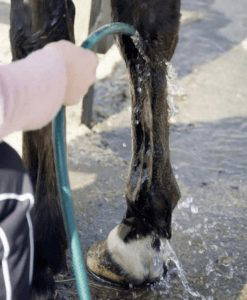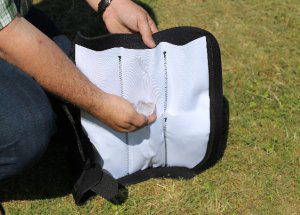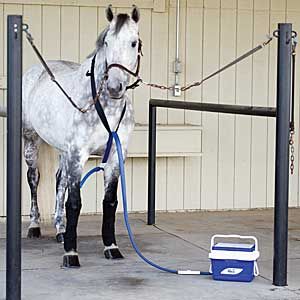We all know that following an injury or after particularly strenuous work that we should limit the damage and help with the healing process by applying something cold to the affected area. But why? And what is the best way to go about it?
 Immediately after an injury an inflammatory response begins with the migration of white blood cells called neutrophils and macrophages to the site of injury. Along with these cells inflammatory mediators also rush in. These inflammatory mediators increase the permeability of capillary walls allowing oedema to develop. Oedema is often visible as a swelling or puffiness and can vary in severity which is usually in relation to the severity of the injury. An increase in temperature may also accompany swelling and can be identified by comparing with the unaffected limb.
Immediately after an injury an inflammatory response begins with the migration of white blood cells called neutrophils and macrophages to the site of injury. Along with these cells inflammatory mediators also rush in. These inflammatory mediators increase the permeability of capillary walls allowing oedema to develop. Oedema is often visible as a swelling or puffiness and can vary in severity which is usually in relation to the severity of the injury. An increase in temperature may also accompany swelling and can be identified by comparing with the unaffected limb.
Whilst inflammation is an important part of the healing process too much swelling can do more harm than good. It can result in increased pressure to surrounding structures which limits the availability of oxygen to healthy cells. Cryotherapy is used in the treatment of soft tissue injury as a method of limiting the secondary ischaemic and enzymatic damage. Cooling the tissues evokes vasoconstriction (a tightening of blood vessels) which limits oedema formation. It also reduces enzyme activity which allows surviving cells to function on a lower oxygen uptake. Pain is also reduced by slowing nerve fibre conduction that relays pain signals and also by acting as a secondary sensory stimulus to stop the brain from focusing on the pain.
The best method of application is often debated with many products available on the market. So, what does the research tell us?
 A cold compress is a simple and low-cost method of applying cryotherapy. Gel packs held in place by a leg bandage can be applied to the treatment area for 10-20 mins to achieve a significant reduction in temperature.
A cold compress is a simple and low-cost method of applying cryotherapy. Gel packs held in place by a leg bandage can be applied to the treatment area for 10-20 mins to achieve a significant reduction in temperature.- The above method prevents uneven tissue contact and maintains a temperature reduction of approximately 10-15 degrees.
- Exact digital temperature required for an effective treatment response is not known. However, research shows metabolic enzyme activity decreases by half for every 10 degrees decrease in tissue temperature.
- Boots containing a mixture of ice and water are available on the market for treatment of the lower limb in horses. However, whilst these boots are reported to be well tolerated by horses they may be difficult and cumbersome to apply and requires a patient horse and handler.
- Wetted ice is suggested to be the most effective at treating injuries and rapidly induces local anaesthesia.
- Sometimes the oldest methods are the best! Cold hosing a limb for 20 minutes is an effective method of cooling tissues. The steady stream of water means that the temperature applied stays constant unlike with ice that melts as it is warmed by its environment.
 Be mindful that if you are using protective boots whilst you are competing and training that these can have a significant heating effect. When galloping the flexor tendon core temperature can increase by up to 6-8 degrees. Over time this can lead to breakdown of the fibres leading to injury. It is suggested that boots should be removed immediately following exercise to prevent damage caused by excessive heating.
Be mindful that if you are using protective boots whilst you are competing and training that these can have a significant heating effect. When galloping the flexor tendon core temperature can increase by up to 6-8 degrees. Over time this can lead to breakdown of the fibres leading to injury. It is suggested that boots should be removed immediately following exercise to prevent damage caused by excessive heating.- Clay’s and gels are also available on the market and work to remove heat through way of evaporation. Make sure bandages are not applied over cooling clays/gels.
- Get in to a routine of checking your horse’s legs to identify any heat, lumps, bumps and swellings. Get in to a habit of walking and trotting your horse up is also another useful tool to assess for signs of injury and lameness. This way you can react quickly to any changes and seek Veterinary intervention.
- It is important to consider that animals are unable to communicate sensory deficits so thorough examination of the skin and careful monitoring will be required when applying any cryotherapy.
Bradfords Veterinary Physiotherapists are well equipped to help guide you in all aspects of your horse’s musculoskeletal health. We pay great attention to detail ensuring that nothing is missed, in this way you ensure the health and wellbeing of your horse and safe guard his health of the future.
Please call 01432890490 or email info@bradfordsvetphysio.co.uk to book.
Search
Recent Articles
Categories
- Advice Hub
- Athlete
- Carriage Driving
- Dentistry
- Dressage
- Endurance
- Eventing
- Farrier
- Featured
- Featured Horse Ads
- Featured Posts
- Horse Racing
- Horse's Mouth
- Horseball
- Hunting
- Le Trec
- Leisure Riders
- Mounted Games
- Nutrition
- Polo
- Polocrosse
- Reining
- Rescue & Rehabilitation
- Show Jumping
- Showing
- Tack Room
- Team Chasing
- The Pony Club
- Therapy
- Training
- Vaulting
- Veterinary




